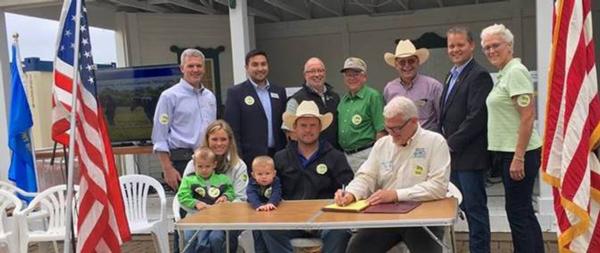Huge CSP Milestone Achieved
August 09, 2017 by UGUIDE South Dakota Pheasant Hunting

Agriculture, Conservation Officials on Hand as Rancher Signs Contract to Put South Dakota Farmers and Ranchers over 7 Million Acre Stewardship Mark
Conservation Milestone celebrated at Sioux Empire Fair today
Sioux Falls, SD, August 9, 2017– At a public ceremony today on the Front Porch of the Sioux Empire Fair, Lyman County producer Reed Petersek signed the contract that put South Dakota farmers and ranchers over 7 million acres of land enrolled in USDA’s Conservation Stewardship Program (CSP).
It’s a conservation milestone for the state’s agricultural producers, who lead the country by a healthy margin—no other state has even 6 million acres enrolled in the program. The signing was part of Ag Appreciation Day at the fair, and State and federal officials were on hand to congratulate and thank producers for their conservation accomplishments that covered 1/6 of the working Ag land acres across South Dakota.
“Our ultimate goal is to improve soil health across the state on croplands, pasturelands and rangelands, and all the positive effects that come downstream with that,” said Karl Jensen, president of the South Dakota Association of Conservation Districts. “The CSP helps with that.”
South Dakota Secretary of Agriculture Mike Jaspers, who has land enrolled in the program, applauded producers for their efforts. “I learned more about how to care for the land with that program, and it incentivizes me to do more,” Jaspers said.
Game, Fish and Wildlife Secretary Kelly Hepler cited wildlife benefits from farmer and rancher work, and Nathan Jensen, Senior Vice President of the Agribusiness Division of First Dakota National Bank pointed out the economic benefits from sound conservation practices. Jensen, who has a farm near Beresford, said many farmers are doing some of the practices outlined in CSP, and called it a natural fit.
“We’re recognizing farmers and ranchers across the state—dedicated stewards who have already done a very good job of conserving soil, water and other resources, but who are willing to take risks to try new practices that take conservation to another level,” said NRCS State Conservationist Jeff Zimprich of Huron. “CSP is a program for working lands—corn, soybeans, and wheat and other crops as well as grasslands. The farmers and ranchers in the program are making those lands even more sustainable for the future. It’s all about making South Dakota better.”
According to NRCS records, in the five-year period between 2011 and 2016, South Dakota ranchers and farmers improved grazing management through CSP on more than 1.1 million acres to benefit wildlife. In that same period, they made 132 miles of fence wildlife friendly for deer, antelope or sage grouse, and they began using practices like flush bars in haying operations on 280,000 acres to reduce loss of nests and young birds.
Among the practices applied through CSP leading to improved water quality are reduced pesticide drift on 1.7 million acres, and plant tissue testing, variable rate fertilizing, and conversion to no-till farming on a combined 1.5 million acres. NRCS also cited the use of cover crops on 300,000 acres and grassland monitoring on 3.4 million acres as significant steps towards soil and rangeland health.






